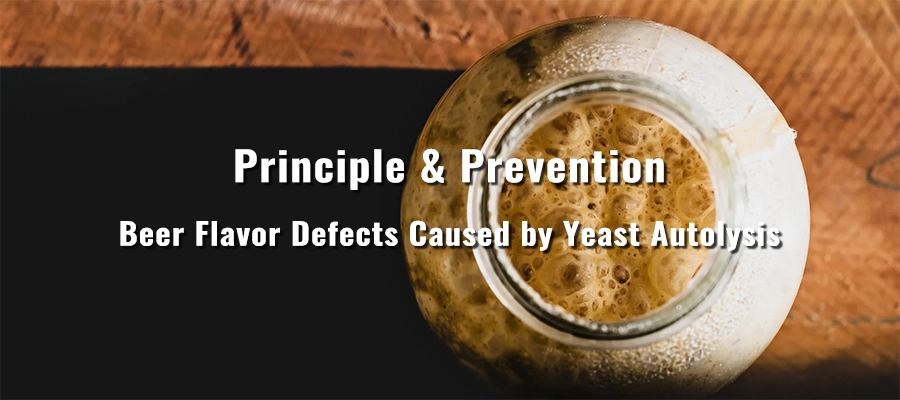Although brewing yeasts have strong vitality and strong cell walls, which can make them survive in an acidic environment with alcohol, but this doesn’t mean that they won’t die, especially in the fermentation environment with long beer storage time and strong survival pressure.
When the yeast dies, yeast autolysis releases some unpleasant flavors into the beer. Also a lot amount of yeast deposits can lead to unpleasant mouthfeel and imperfections.
Overview
For a long time, the cause of yeast autolysis has not been thoroughly studied. But after a long period of exploration, it was found that the death of yeast can be called “the final show”of itself, after the yeast die, it donates the nutrients that it stores to the other yeasts.
Yeast autophagy is its own operating mechanism. When some yeasts are unimportant or senescent, other yeasts will decompose these senescent yeast cells. This creates a cycle of the yeast itself, by breaking down senescent cells, thereby releasing the nutrients inside again.
The Effect of Yeast Autolysis on Beer
The death and autolysis of yeast cells are normal phenomena. The reason for yeast autolysis is that it has enzymes in its cells, which will decompose the intracellular structure and cell membrane after death, eventually causing cell contents and some decomposition products to penetrate into the beer through the damaged cell membrane.
In particular, for some short-chain fatty acids and amino acids contribute to some unpleasant yeasty and musty odors. Fatty acids also have a soapy smell when they break down. At the same time, some macromolecular substances on the cell membrane can also cause the turbidity of the beer.
The amino acids and nucleotides released by the autolyzed yeast also give the beer an incongruous bitter taste with meaty and sulfuric notes. If the amount of yeast autolyzed yeast is large, these substances will also significantly increase the pH of the beer, further changing the taste.
beer, thus affecting the stability of the beer head foam. In bottling beer with secondary fermentation, complex non-fermentable sugars are enzymatically broken down into simple fermentable sugars, then consumed by other living yeasts, causing over-carbonation and other problems.
In addition, these autolysates also provide a good nutrient environment for bacterial contamination.
In summary, the adverse effects of yeast autolysis are:
- The stability of the head foam becomes poor, and the foam disappears quickly
- Flavor defects: Yeast, meat, musty, creosote, soapy, etc.
- pH rise
- Increase the risk of bacterial contamination
- The color of the beer changes
- Turbidity, and filtration becomes more difficult
- Decreased beer taste stability
- Diacetyl content increased (caused by insufficient reduction)
- Bitterness is prolonged
Measures to Prevent / Reduce Yeast Autolysis
Choose healthy yeast
Use yeast with healthy, strong vitality(vital doesn’t mean whether the yeast is alive, but whether the yeast is active).
The key to a healthy yeast population is a base of young and vigorous yeast population. They are rich in nutrients and when supplied with oxygen, enter the yeast growth phase (exponential growth), It can be analyzed from this that yeast is very easy to reproduce in a small area.
In addition to increasing the survival pressure of yeast and promoting the possibility of autolysis, excessive recycling and reuse of yeast will also increase the possibility of contamination by lactic acid bacteria and other wild yeasts.
Fermentation condition control
Avoid high fermentation temperatures (especially above 26℃), or sudden and rapid temperature changes. Inoculating yeast directly into wort that is too high in sugar also exposes the yeast to osmotic shock.
After the main fermentation, pour the barrel (home brew) / row the yeast (commercial brew) in time, leaving the yeast precipitate in the fermentation tank for a long time will also cause the beer to produce flavor defects caused by yeast autolysis. Fermenters with yeast will last about two weeks for ale that ferments at higher temperatures, while lagers stored at low temperatures will last slightly longer.
Factors that affect yeast activity are alcohol content, nutrient content, and fermenter pressure. Different yeast strains also have different sensitivity to alcohol, carbon dioxide and acidity, so the corresponding fermentation conditions should be controlled according to the type of yeast strain.
Measures when canning
In order to avoid yeast autolysis as much as possible, the beer should be brought into the yeast deposit as little as possible when canning. In order to meet the carbonation of secondary fermentation, about 0.5-100 million yeast cells per ml of beer will be enough, if not, new yeast can be added.
After the main fermentation is done, can use some physical separation methods (such as filtration or long-term low temperature sedimentation) to reduce the amount of yeast entering the tank. In theory, however, there is enough yeast to carbonize even in an almost clear beer.
Conclusion
Autolysis of yeast is unavoidable, but it can be delayed by using yeast with strong pressure resistance and lower storage temperature. At the same time, if the amount of yeast in the final tank is low, the impact on the taste will be minimized.




